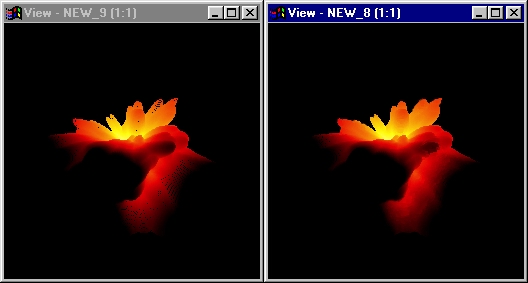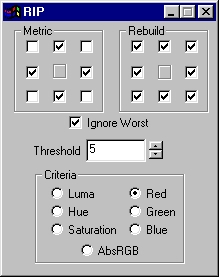| This is a child page. You can use Parent in the quick nav bar at the top or the bottom of the page to navigate directly back to the parent of this page. Some child pages are more than one level deep, and in that case will require more than one Parent click to reach the outermost document level. |
§ 16.49 - RIP - Remove Isolated Pixel
| Quick Reference to Scripting Command |
| a=RIP(TL, TC, TR, L, R, BL, BC, BR, RTL, RTC, RTR, RL, RR, RBL, RBC, RBR, threshold, MODE[0-6], IGNORE WORST) |
| Items in CAPS are 0/1 or ranges with more options than just 0/1. Ranges other than 0/1 are indicated by brackets, such as [0-2]. |

RIP is short for Remove Isolated Pixel. This operator allows you to filter out discolored pixels in an image. The image on the left was changed to the image on the right by applying RIP based on the red channel. Now the image is smooth, continuous and more appealing to the eye.
§ 16.49.1 - RIP Controls
§ 16.49.1.1 - Metric
The eight checkboxes surrounding the center box control how each pixel is compared against its neighbors. The upper left checkbox will control whether or not the pixel to the upper left will be considered in the average and so on. If the selected criteria (more below) of the average and the criteria of the pixel in question have a difference greater than the threshold (more below), it will be marked to be rebuilt.
§ 16.49.1.2 - Rebuild
The controls for rebuild function in the same way as the metric controls. If the pixel is marked to be rebuilt, the surrounding pixels you chose will be sampled and an average color will be determined. The pixel marked for replacement will be changed to the average color.
If a pixel is marked to be rebuilt, it will not be taken into the average. The reason for this is best described by a simple example. Consider 2 black pixels surrounded by white. Taking the average of all the surrounding colors will turn the black colors 1/8 gray because the neighboring black pixel and the surrounding white pixels are averaged. If the neighboring black pixels are excluded, the black pixels will become white, this allows RIP to be a true remove effect and not a blur.
§ 16.49.1.3 - Ignore Worst
Consider again, the white and black pixels example. If the pixel to the upper left of a black pixel was scanned to determine replacement, the average color would be calculated to be 1/8 gray while in actuality the discontinuous pixel is throwing the average off. This pixel may be marked for replacement unnecessarily. Selecting ignore worst will always throw out the most extreme value before the surrounding values are averaged and a comparison is made.
§ 16.49.1.4 - Threshold
Threshold ranges from 0 to 255. This determines at what difference from the average will pixels be marked to be replaced. High values will only remove extreme differences while a low threshold will remove much more subtle discontinuities.
§ 16.49.1.5 - Criteria
Luma: This chooses the luma to be the determining factor when a pixel is compared against adjacent pixels. The luma of that pixel is determined, the average luma is determined, a difference is taken, then the decision is made to RIP.
Hue: This selects the hue of the pixel and the average hue to be the determining factors in the RIP.
Saturation: This selects the saturation to be the determining factor in the RIP..
Red: This selects the red to be the determining factor in the RIP.
Green: This selects the green to be the determining factor in the RIP.
Blue: This selects the blue to be the determining factor in the RIP.
AbsRGB: This selects 3 OR'd comparisons: red, green and blue. If any of these differences are greater than the threshold, the pixel will be replaced.
, Previous Page . Next Page t TOC i Index o Operators g Glossary
Copyright © 1992-2007 Black Belt Systems ALL RIGHTS RESERVED Under the Pan-American Conventions
WinImages F/x Manual Version 7, Revision 6, Level A

